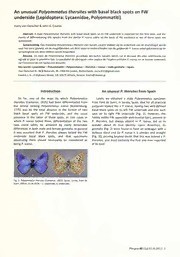
An unusual Polyommatus thersites with basal black spots on FW underside (Lepidoptera: Lycaenidae, Polyommatiti) PDF
Preview An unusual Polyommatus thersites with basal black spots on FW underside (Lepidoptera: Lycaenidae, Polyommatiti)
An unusual Polyommatus thersites with basal black spots on FW underside (Lepidoptera: Lycaenidae, Polyommatiti) HarryvanOorschot&JohnG.Coutsis Abstract.AmalePolyommatusthersites\withbasalblackspotsonltsFWundersideisreportedforthefirsttime,andthe meritsofdifferentiatingthisspeciesfromthesimilarP. icarussolelyonthebasisoftheexistenceornotofthesespotsare questioned. Samenvatting.EenmannetjePolyommatusthersitesmetbasale,zwartevlekkenopdeonderkantvandevoorvleugelwordt voorheteerstgemeld,endemogelijkhedenomdezesoortteonderscheidenvandegelijkendeP.icarusenkelgebaseerdopde aanwezigheidvandezevlekkenwordtbesproken. Résumé. UnmaledePolyommatusthersitespossédantdestachesbasalesnoiressurIedessousdesailesantérieuresest signaléicipourlapremièrefois.Lapossibilitédedistinguercetteespècedel'espècesimilaireP.icarus,ensebasantseulement surl'existencedecestachesestdiscutée. Keywords:Lycaenidae-Polyommatiti-Polyommatus-thersites-icarus-malegenitalia-Spain. VanOorschotH.:NCBNaturalis,NL-2300RALeiden,[email protected] CoutsisJ.G.:4GlykonosStreet,GR-10675Athens,[email protected] Introduction AnunusualP. thersitesfromSpain So far, one of the ways by which Polyommatus Lately we obtained a male Polyommatus specimen thersites (Cantener, 1835) had been differentiated from from PontdeSuert,in Lerida,Spain,thatforall practical the similar looking Polyommatus icarus (Rottemburg, purposeslooked likeaP. icarus, havingtwowell-defined 1775) was by the total absence in the former of two basal blackspotson its left FW undersideand onesuch black basal spots on FW underside, and the usual spot on its right FW underside (Fig. 1). Flowever, the presence in the latter of these spots. In rare cases in faintlyvisibleFWuppersideandroconial hairs,presentin which P. icarus lacked them, differentiation ofthe two P. thersites, but always absent in P. icarus, led us to taxa could safely be achieved by easily detectable wander about its true identity. Upon dissection, its differencesin both maleandfemalegenitalia. Ingeneral genitalia (Fig. 2)werefoundto havean aedeaguswitha it was assumed that P. thersites always lacked the FW bulbousdistal end [in P. icarus it isslenderand straight underside basal black spots, and that specimens (Fig. 3)], provingbeyond doubtthatthiswasindeeda P. possessing them should necessarily be considered as thersites, and mostcertainlythefirstoneever reported beingP.icarus. ofitskind. Fig.1.Polyommatusthersites(Cantener,1835).Spain,Lerida,Pontde Suert,900m,15.vii.1974.-a.Upperside,b.Underside. Phegea40(la)Ol.iii.2012:3 Fig.2.Polyommatusthersites (Cantener,1835).Spain, Lerida,PontdeSuert,900m, 15.vii.1974.Prep.No.4544. Genitaliccomponents.-a. Lateralaspectofouterfaceof leftvalve;b.Dorsalaspectof aedeagus;c.Lateralaspectof leftsideofgenitalia,with valvaeandaedeagusomitted; d.Ventralaspectofrighthalf oftegumentogetherwithright labisandfalx. Fig.3.Polyommatusicarus (Rottemburg,1775).Spain, Albacete,Riopar,1200m,25- 26.vi.l995.Prep.No.2672. Genitaliccomponents.-a. Lateralaspectofouterfaceof leftvalve;b.Dorsalaspectof aedeagus;c.Lateralaspectof leftsideofgenitalia,with valvaeandaedeagusomitted; d.Ventralaspectofrighthalf oftegumentogetherwithright labisandfalx. Conclusions genitalia. In the males in particular, differentiating the two taxa solely by reference to the FW upperside Thisrecentfindsuggeststhattheonlyfool-proofway androconial hairs applies mostly to fresh specimens, as toalwaysdifferentiatebothmaleandfemaleP. thersites these hairs are often difficult to detect in worn P. from P. icarus is by reference to their respective thersites. Phegea40(la)01.iii.2012:4
